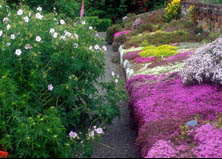Preparing the garden for winter
 It's now mid-November and the garden has been well prepared for winter. All the herbaceous perennials have been cut down, leaving the outline of beds traced by the box hedges and paths, the soil tidy and weeded and everything dormant for the next few months. The garden still has wonderful winter structure thanks to the hedges, the topiary and the tall grasses which are left standing. Teasels stand high, sheltered from the winds by the garden walls, and a feast for goldfinches who love their seeds. The shelter provided by the woods (tall sculptural beeches in particular) has its downside in the vast number of leaves that flood into the garden, covering the lawns and paths. We collect the leaves for leafmould which is then put on the vegetable garden and the National Collection of Sanguisorba. Some leaves are simply raked onto the shrub borders to make a deep, rich mulch.
It's now mid-November and the garden has been well prepared for winter. All the herbaceous perennials have been cut down, leaving the outline of beds traced by the box hedges and paths, the soil tidy and weeded and everything dormant for the next few months. The garden still has wonderful winter structure thanks to the hedges, the topiary and the tall grasses which are left standing. Teasels stand high, sheltered from the winds by the garden walls, and a feast for goldfinches who love their seeds. The shelter provided by the woods (tall sculptural beeches in particular) has its downside in the vast number of leaves that flood into the garden, covering the lawns and paths. We collect the leaves for leafmould which is then put on the vegetable garden and the National Collection of Sanguisorba. Some leaves are simply raked onto the shrub borders to make a deep, rich mulch.
In the greenhouse, everthing that isn't evergreen has also been cut back; lemon verbena, blackcurrant sage, passion flower, Rosa banksiae lutea, balm of gilead and other scented delights. I do this before the leaves drop so there is less clearing up to do. The grape vine has been pruned (see blog posting of Nov 07) and the rest of the grapes were put out for the blackbirds who cleared the lot away in a couple of days! They do love fruit. This picture is of the luscious bunches of dark grapes heaped on one of the tables for sale (www.gardart.co.uk) ready to go out for the birds. To the right is my original plant of Erigeron karvinskianus whose offspring have been sold in the nursery for some years and seedlings of which now survive outside in the garden.



